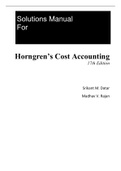Exam (elaborations)
Horngren's Cost Accounting, A Managerial Emphasis 17th Edition By Srikant Datar, Madhav Rajan (Solution Manual)
- Course
- Institution
Horngren's Cost Accounting, A Managerial Emphasis, 17e Srikant Datar, Madhav Rajan (Solution Manual) Horngren's Cost Accounting, A Managerial Emphasis, 17e Srikant Datar, Madhav Rajan (Solution Manual)
[Show more]



